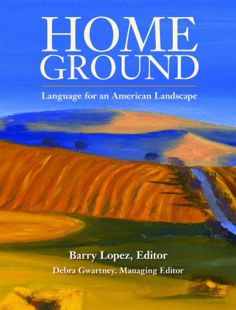The Language of Landscape
Air Date: Week of September 11, 2009

Living on Earth continues its series exploring features of the American landscape, based on the book Home Ground: Language for an American Landscape, edited by Barry Lopez and Debra Gwartney. In this installment, Donna Seaman explains the term "commons."
Transcript
CURWOOD: From naming nature – to naming our landscape. The features of our American geography are the theme of our occasional series Home Ground.
Today writer Donna Seaman defines a term dear to many lovers of the countryside – commons.
SEAMAN: Commons. A common, or commons, is land that belongs to an entire community. More specifically, it is open land held in common by the people of a town for shared pasturage or the gathering of firewood. As noted in A Gazetteer of Illinois in 1834 by J.M. Peck, “A common is a tract of land…in which each owner of a village lot has a common but not an individual right. In some cases this tract embraces several thousand acres – the common attached to Cahokia extends up the prairie opposite St. Louis.” In her book Red: Passion and Patience in the Desert, Terry Tempest Williams notes that “most lands in the American West are public lands, a commons if you will, held inside a national trust: national forests, Bureau of Land Management lands, national parks, monuments, and refuges.” I say, these are the commons of a global village, preserved with common sense and commitment to the common good.
CURWOOD: Donna Seaman is a writer and editor based in Illinois. Her definition of commons comes from the book Home Ground: Language for an American Landscape, edited by Barry Lopez and Debra Gwartney.
[MUSIC: Brian Blade “Struggling With That” from Mama Rosa (Nonesuch 2009)]
YOUNG: Just ahead – could part of the prescription for saving Brazil’s biodiversity be … snake oil? Stay with us - on Living on Earth.
ANNOUNCER Support for the environmental health desk at Living On Earth comes from the Cedar Tree Foundation. Support also comes from the Richard and Rhoda Goldman fund for coverage of population and the environment. And from Gilman Ordway for coverage of conservation and environmental change. This is Living On Earth on PRI, Public Radio International.
Links
Living on Earth wants to hear from you!
Living on Earth
62 Calef Highway, Suite 212
Lee, NH 03861
Telephone: 617-287-4121
E-mail: comments@loe.org
Newsletter [Click here]
Donate to Living on Earth!
Living on Earth is an independent media program and relies entirely on contributions from listeners and institutions supporting public service. Please donate now to preserve an independent environmental voice.
NewsletterLiving on Earth offers a weekly delivery of the show's rundown to your mailbox. Sign up for our newsletter today!
 Sailors For The Sea: Be the change you want to sea.
Sailors For The Sea: Be the change you want to sea.
 The Grantham Foundation for the Protection of the Environment: Committed to protecting and improving the health of the global environment.
The Grantham Foundation for the Protection of the Environment: Committed to protecting and improving the health of the global environment.
 Contribute to Living on Earth and receive, as our gift to you, an archival print of one of Mark Seth Lender's extraordinary wildlife photographs. Follow the link to see Mark's current collection of photographs.
Contribute to Living on Earth and receive, as our gift to you, an archival print of one of Mark Seth Lender's extraordinary wildlife photographs. Follow the link to see Mark's current collection of photographs.
 Buy a signed copy of Mark Seth Lender's book Smeagull the Seagull & support Living on Earth
Buy a signed copy of Mark Seth Lender's book Smeagull the Seagull & support Living on Earth

